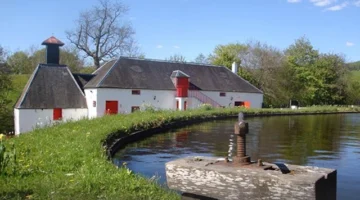Scottish Mezcal
Making Scottish mezcal isn’t possible but it’s now easier to buy mezcal in Scotland thanks to the importing of Pelo del Perro (or Hair of the Dog) from Mexico.

You can’t make mezcal in Scotland, any more than you can make Scotch whisky in Mexico. Mezcal can only be made in certain parts of Mexico, but it recently became easier to buy it thanks to Pelo del Perro, a mezcal from Oaxaca that’s made by a father-and-son team on their organic farm.
What Is Mezcal?
For the full answer to that, see our page on What is Mezcal?
Mezcal is also one of my favourite spirits. It bears a resemblance to smoky whiskies from Islay, but with a nod towards tequila. Mezcal can be made from any agave plant, but tequila can only be made from the blue agave. So technically tequila is a mezcal but no mezcal is a tequila as makers use any agave but the blue agave.
Although Mexico has about two hundred different types of agave plants, only about thirty are suitable for making mezcal, and of those only about seven are used to make the best and most popular mezcals. This means that mezcals have a wide range of tastes, and just as Laphroaig is different from Lagavulin, mezcals vary in taste depending on which type of agave was used, and the methods used by the distiller.
Pelo del Perro
Pelo del Perro is a great name for a mezcal as it’s Spanish for ‘Hair of the Dog’.
Pelo del Perro
Pelo del Perro is a great name for a mezcal as it’s Spanish for ‘Hair of the Dog’.
Mezcal’s Appeal
For me, part of mezcal’s appeal is the variety of tastes that you get, without straying too far from home. It’s also a small-batch spirit. Whereas most tequilas are made in huge distilleries, thanks to the drink’s popularity, mezcals tend to be made by small-batch distillers using their local agave plants. Many of them are family concerns, and Pelo del Perro is just that, a father and son team: Felipe and Ageo Cortez.

Making Mezcal
The smoky flavours of mezcal come about because the piñas, or hearts, of the agave plant are roasted in sealed underground pits, so the smoke is embedded into the roasted agaves. These are then crushed in traditional fashion, on a grinding wheel pulled by an ox. The result is then fermented and distilled, to produce mezcal.
But Why Scottish Mezcal?

Importer George Hailstone went to Mexico, fell in love with mezcal, and decided he wanted to help these artisan distillers reach a larger market. Being from Scotland, he saw his native country as being a natural market, and felt sure that his whisky-loving fellow countrymen would also fall for this distinctive spirit.

Types of Agave
Pelo del Perro’s Scottish adventure begins with two mezcals. One is made from one of the most popular and best agaves used for making mezcal: espadin. The other is made from a lesser-known agave plant, the madrecuishe.

Tasting Pelo del Perro Espadin
The espadin agave accounts for about 90% of all mezcals made, for various reasons – it’s easy to grow, takes less time to mature and is high in sugar content, so you get more alcohol per plant than from other varieties. No surprise, then, that the Cortes’s decided to use the espadin for their first commercial release – they’ve been making mezcal within the family for over forty years.
The agave used were six-to-seven years old, were roasted for ten days (including two days of cooling), rested for five days, fermented for twelve days, then distilled and bottled at 45% ABV. This is typical for a mezcal, as by and large they tend to be bottled at a slightly greater strength than the average tequila.

Taking the cork out of the bottle reminds me why I love mezcal. I haven’t had any for a few months now, but right away the distinctive earthy yet sweet aroma is there. It’s there even more when you take a sip (mezcal is at its best when neat but works with tonic and other mixers, and in cocktails).
The medley of flavours comes through. It’s smoky, it’s got vanilla and caramel, and it’s got citrus flavours too. All in all it’s a delight, and one of the best mezcals I’ve tasted. I can imagine making a margarita with this, with the smoky mezcal replacing tequila to produce a different kind of a drink.

Tasting Pelo del Perro Madrecuishe
The distillers use the madrecuishe agave as it’s very local to their area. The plants aren’t harvested till they’re nine years old, and then they’re roasted for fifteen days, rested for five days, fermented for eight days, and finally distilled in 350 litre copper alembic stills. Only 450 litres is made at a time, and the result is bottled using natural spring water at 49.2% ABV. It’s therefore quite a feisty spirit.

It’s also a new one for me. It’s always exciting to try a new mezcal, and I’ve never had one made from the madrecuishe agave before. The difference? Well, on the nose it smells surprisingly sweet. Sipping it, the sweetness somehow gives way to a much earthier taste, as if it’s made not just from the agave but also the soil that it grows in. It’s a pleasing contrast to the espadin, and a reminder that it’s not just wine that has terroir.
The extra alcohol strength is certainly noticeable too, sipping it neat, although it is also surprisingly smooth, like a top-class whisky. Which is what a good mezcal is. If you’re a scotch drinker but haven’t tried mezcal yet, then give it a go. You’ll be pleasantly surprised.

Buying Scottish Mezcal
You can buy the two mezcals from the Pelo del Perro website, with free shipping if you buy two or more bottles.
Check them out on Instagram too at @pelodelperromezcal.











